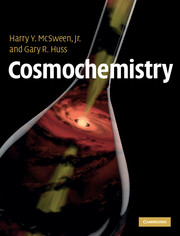Book contents
- Frontmatter
- Contents
- Preface
- 1 Introduction to cosmochemistry
- 2 Nuclides and elements: the building blocks of matter
- 3 Origin of the elements
- 4 Solar system and cosmic abundances: elements and isotopes
- 5 Presolar grains: a record of stellar nucleosynthesis and processes in interstellar space
- 6 Meteorites: a record of nebular and planetary processes
- 7 Cosmochemical and geochemical fractionations
- 8 Radioisotopes as chronometers
- 9 Chronology of the solar system from radioactive isotopes
- 10 The most volatile elements and compounds: organic matter, noble gases, and ices
- 11 Chemistry of anhydrous planetesimals
- 12 Chemistry of comets and other ice-bearing planetesimals
- 13 Geochemical exploration of planets: Moon and Mars as case studies
- 14 Cosmochemical models for the formation of the solar system
- Appendix: Some analytical techniques commonly used in cosmochemistry
- Index
- References
7 - Cosmochemical and geochemical fractionations
Published online by Cambridge University Press: 05 June 2012
- Frontmatter
- Contents
- Preface
- 1 Introduction to cosmochemistry
- 2 Nuclides and elements: the building blocks of matter
- 3 Origin of the elements
- 4 Solar system and cosmic abundances: elements and isotopes
- 5 Presolar grains: a record of stellar nucleosynthesis and processes in interstellar space
- 6 Meteorites: a record of nebular and planetary processes
- 7 Cosmochemical and geochemical fractionations
- 8 Radioisotopes as chronometers
- 9 Chronology of the solar system from radioactive isotopes
- 10 The most volatile elements and compounds: organic matter, noble gases, and ices
- 11 Chemistry of anhydrous planetesimals
- 12 Chemistry of comets and other ice-bearing planetesimals
- 13 Geochemical exploration of planets: Moon and Mars as case studies
- 14 Cosmochemical models for the formation of the solar system
- Appendix: Some analytical techniques commonly used in cosmochemistry
- Index
- References
Summary
Overview
Various processes that lead to the separation of elements from each other, or isotopes of the same element from each other, are considered. Examples of such processes are evaporation and condensation (which separate elements based on volatility), melting and crystallization, physical mixing and unmixing of components, and changes in redox conditions. We explain the basics of equilibrium condensation and how condensation sequences are calculated, and discuss the applicability of the condensation theory to the early solar nebula. We explore whether processes that separated elements as a function of their volatility occurred under equilibrium conditions, or were kinetically controlled. Isotopic fractionations may accompany volatility-controlled fractionations under specific conditions and can be diagnostic to inferring the formation conditions for various objects. The roles of other types of elemental fractionations in the solar system are also discussed, including the physical sorting and segregation of chondrite components and the element fractionations resulting from melting, crystallization, and planetary differentiation. Finally, we explore how light stable isotopes have been fractionated in the nebula, in the interstellar medium, and in planetesimals and planets, and show why elemental fractionations are critical for using radioactive isotopes as chronometers.
What are chemical fractionations and why are they important?
The solar system formed from a well-mixed collection of gas and dust inherited from its parent molecular cloud. The bulk composition of this material, as best we can know it, is given by the solar system abundances of elements and isotopes (Tables 4.1 and 4.2).
- Type
- Chapter
- Information
- Cosmochemistry , pp. 192 - 229Publisher: Cambridge University PressPrint publication year: 2010



